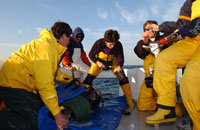Our tagging efforts,
initially scheduled to commence on May 14th, following the ICCAT SCRS Meeting, were delayed due to heavy winds and anxious seas, which posed too much
risk for both the divers and the tuna. After waiting five days for
the winds to subside and the seas to calm, we headed to the port town of
Larache on May 19 and attempted to initiate the tagging
operation. Although the winds had calmed, the swell remained high,
and still posed too much risk for the team, but weather forecasts appeared
promising for the following morning.
 |
Waiting for a calm weather window.
Image: George Shillinger |
 |
Anchors await deployment at the Société Maromadraba
offices in Larache, Morocco.
Image:
Pablo Cermeño |
We decided to divide the tag deployment efforts
into two different methodologies to examine for any bias in movement behavior
that might be associated with the tagging procedures. One-half of
the PAT-tagged fish (n=7) would be tagged on board and the other half would be
tagged in the water while the fish were in the chamber.
 |
Diver
guides tuna into the ‘tagging chamber’.
Image: George Shillinger |
 |
Artisanal
fishermen assist with the tag deployment effort.
Image: George Shillinger |
 |
Fishermen prepare the trap for tagging.
Image: George Shillinger |
The trapped fish were lead into a
smaller chamber, surrounded by the fishermen. The fishermen worked to manually
lift the nets, and brought the tuna to a depth (~ 20m) accessible to the
divers. Divers manually captured each tuna and shepherded them into
slings, where they rolled over underwater, belly side up.
 |
Fishermen
draw the nets while divers await access to the trapped fish.
Image: George Shillinger |
 |
Lowering
the giant tuna sling into the tagging chamber -- to awaiting divers and fish.
Image: George
Shillinger
|
 |
Tuna and
diver square off in the trap.
Image: George Shillinger |
 |
A skilled
tuna trap diver captures and rolls a bluefin, in preparation for maneuvering the
fish into the sling.
Image: George Shillinger |
A huge stretcher and a crane were used to hoist the tuna onboard
the tagging vessel. The remainder of the tagging operation followed standard
TAG deployment procedures used in North Carolina, Canada, and elsewhere around
the world. The team double-tagged seven fish (ranging from ~215-250
cm CFL) with seven Wildlife Computer mini-PATs and seven VEMCO V16 acoustic
tags. An additional tuna was tagged with a single Vemco V16 acoustic
tag. The following morning, another seven fish were tagged in the
water with Wildlife Computer mini-PATs.
 |
A bluefin
is released from the sling following a successful double-tag (mini-PAT and
acoustic) deployment.
Image: George Shillinger |
 |
Carefully
coordinated teamwork is essential for successful tag deployments on Moroccan trap
tuna.
Image: George Shillinger |
This year’s Moroccan trap tagging effort was an outstanding
success and an excellent example of collaborative research linking together
artisanal fishermen, scientists, and fisheries managers.
 |
Dr. Pablo Cermeño
smiles as another tagged tuna departs the trap.
Image: George Shillinger |
 |
The 2013 Morocco Atlantic bluefin tagging team.
Image: George Shillinger |
The ancient Moroccan trap
fishery presents a unique opportunity to expand the state of knowledge about
bluefin tuna research and conservation, and TAG is proud to contribute to this
effort!

















2 comments:
Can we do the same tagging for the Philippines' interest. How about tagging additional 5 year old female Pacific Bluefin Tuna somewhere in the waters between New Zealand and Solomon Islands and/or New Guinea to validate if the individuals follow the North Pacific Gyre (swim with the current) passing along the Philippine eastern shores until they reach the spawning area. Who needs to make the proposal, should it be the Focal Person of Philippines Coral Triangle Initiatives or the Fisheries Undersecretary under the Department of Agriculture?
This is cool!
Post a Comment